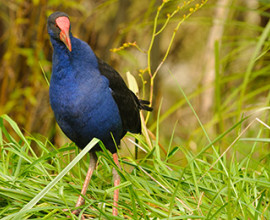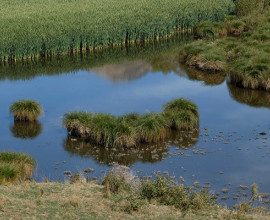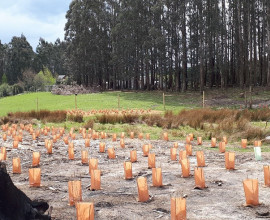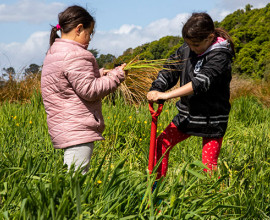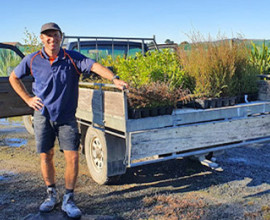Canterbury wetland types
Canterbury has a variety of saltwater and freshwater wetlands across the region, stretching from the coastal to alpine zones. While certain plants and wildlife are often found in wetlands according to their type and location, each wetland is a unique ecosystem.
For more information on what regulations might apply to these unique wetlands, please refer to our Wetland Management page, or contact your zone's Land Management Advisor.
Swamps
Swamps are the most common wetland type found across the Canterbury Plains and on private land in our region.
Swamps are fertile wetlands that are usually found on plains, basins and valley floors. Unlike bogs and fens, they receive water from land surface drainage, which is subject to seasonal changes in water levels. This water flows across the land, collecting nutrients and depositing them into the wetland.
Common swamp plants in New Zealand and Canterbury include bullrush/raupō, flax/harakeke and swamp sedge/pukio.
Ōruapaeroa/Travis wetland is a freshwater swamp in Christchurch. This is a large freshwater wetland and is an important habitat for native wetland plants and birds.
Bogs and fens
Bogs are mostly found on flat land and are usually wet, with their water table close to the surface. They get all their water from rain or snow, which means they don't usually receive the same amount of nutrients as wetlands fed by ground and surface water.
Fens on the other hand are located on slopes or the edges of raised bogs and are fed by rainwater as well as groundwater, which means they get extra nutrients from adjacent soils. Bogs and fens also contain an organic material, peat substrate, which is made up of partially decomposed plants.
Common plants found in Canterbury's bogs and fens include moss/pūkohu, lichens, rushes, and orchids.
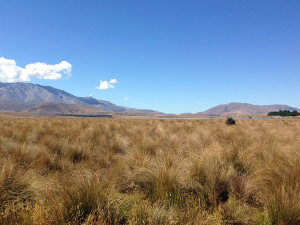
Cameron Fan, Lake Heron is an example of a red tussock fen. Red tussock and bog rush fens can be found in Canterbury's high-country basins.
Estuaries and coastal lagoons
Estuaries occur where freshwater from rivers mixes with saltwater from the ocean, while coastal lagoons are shallow waterbodies with a barrier to the ocean which may periodically open through an inlet.
Estuaries and coastal lagoons are some of Canterbury's most productive wetland types and are generally rich in animal life. This means they are also an important place for mahinga kai gathering.
Common plants found in Canterbury's estuaries and coastal lagoons include marsh ribbonwood/mākaka, sea rush/wīwī and jointed wire rush/oioi.
Find out more about estuaries in the region and their health on the LAWA website.
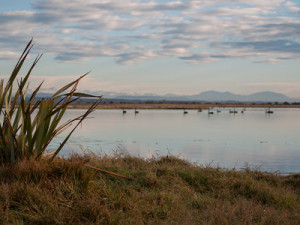
Wainono Lagoon is a 480-hectare coastal lagoon and wetland in South Canterbury, known for its birdlife and native fish. Several rivers flow into the lagoon, including the Hook and Waihao Rivers. Despite being only metres away from the Pacific Ocean, it is a brackish lagoon (fresh-saltwater mix) and separated from the sea by a gravel berm.
Lacustrine wetlands
Lacustrine wetlands are connected to lakes and ponds and have different characteristics depending on their location. In Canterbury, they exist in various locations including the margins of coastal lagoons, such as Te Waihora/Lake Ellesmere, and on the margins of high country lakes, such as those at Takapō/Tekapo.
Plants associated with lacustrine wetlands in Canterbury include aquatic macrophytes like pondweed/manihi and tall reed-like plants such as raupō and giant rushes closer to the edges.
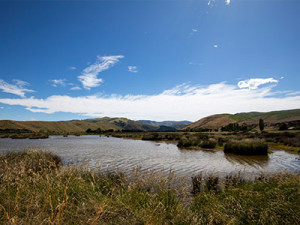
Te Waihora/Lake Ellesmere is a lagoon located to the west of Banks Peninsula that has no permanent outlet to the sea. It covers 198 square kilometres and includes some of New Zealand's most important wetland ecosystems, including lacustrine wetland areas along its margins. Its water is also brackish, with fluctuating salinity levels.
Riverine wetlands
Riverine wetlands are connected to the water flowing from rivers and streams. These are common in the braided river systems of Canterbury, which form dynamic channels that weave across the riverbed and move sediment over time. Riverine wetlands are influenced by the surface and subsurface flow and movement of waters associated with the river system.
Several rare birds have evolved in the braided river ecosystems of Canterbury, including the iconic wrybill/ngutu pare, which is the only species in the world with a bill that bends sideways. Other engendered birds that nest in these spaces include the banded dotterel/tūturiwhatu, the black-billed gull/tarāpuka, and the black-fronted tern/tarapirohe.
Vegetation in these wetlands includes aquatic plants, algae, floating ferns and herbs.
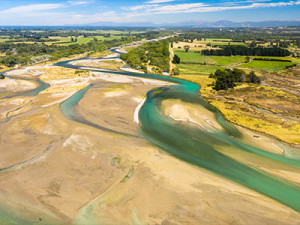
The Ashley River/Rakahuri starts with headwaters in the Puketeraki Range and after flowing through the Ashley Gorge it emerges as a braided river before entering the Pacific Ocean at Waikuku Beach. This river is relatively steep compared with other braided rivers in Canterbury and moves a substantial amount of sediment.

